

 The South African
The South African
by John Shaw
The events that took place at Dwarsvlei came to the writer's notice quite by chance and the following article is an attempt to share this knowledge with readers who may have similar interests. The writer feels that, because of the proximity of the site to the major city of Johannesburg and the openness of the terrain some sort of diorama describing the events should be erected at the side of the road or on the top of the westem kopje.
The farm Dwarsvlei is situated 15 kilometres north of Krugersdorp on the road to Hekpoort, past Sterkfontein of archaeological fame. It is still owned and farmed by descendants of the Oosthuizen family, the Voortrekkers who first settled there. It was the scene of at least two almost forgotten clashes between the Boers and the British during the Anglo-Boer War (1899 - 1902)
The first incident, which took place on 11 July 1900, was a fierce battle in which three Victoria Crosses(1) were earned in circumstances initially remarkably similar to the battle of Colenso seven months earlier (15 December 1899). Amongst the Boer casualties was their commander, Sarel Oosthuizen. The engagement was described by Major-General Smith-Dorrien as their 'most trying fight of the whole war'.(2)
Then, on 9 October 1900, a captain in the Royal Scots Fusiliers, Hugh Montague Trenchard, was ambushed and critically wounded outside the door of the farmhouse in the second incident which occurred on the farm during the war. Trenchard survived to become 'one of the few great men, who can be said to have changed the course of history'.(3) He became 'the father of the Royal Air Force and the architect of modern air power', dictating the role of aerial bombing warfare in both the First and Second World Wars. He fought economic cuts to keep the air force in existence between the wars and it is said that, 'without him, there would have been no Battle of Britain'.(4)
Today, only a short drive from Johannesburg, the tarred road to Hekpoort passes over the battlefield of Dwarsvlei, but there is no indication of the events that took place there a century ago. Not even a cartridge case remains to be seen, although the British alone fired 38 000 rounds that day.(5) The farm and the slope of the Witwatersberg to the north are now covered with invasive wattle trees, but the two kopjes and the hollow beyond them remains open veld as it was a century ago. Thus, the panorama of the battlefield can be easily surveyed. The positioning of the roads has changed slightly over time, as Smith-Dorrien's map shows the Hekpoort road to be to the west of the kopjes, while the present tarred road follows the path between them taken by the guns.
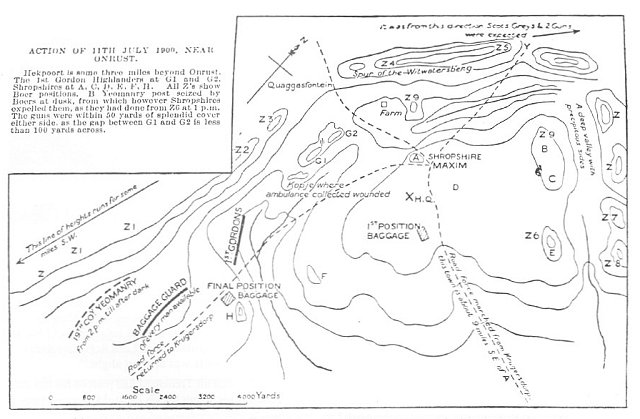
Map of action of 11 July 1900.
(Source: Smith-Dorrien, Memories of forty-eight years' service, p 219.)
It was mid-winter on the Highveld, Pretoria had fallen to the British, and General de la Rey had gathered the burghers north of the Magaliesberg for the start of the guerrilla phase of the war. On that day, 11 July 1900, the British were engaged at four places: Witpoort, east of Pretoria; Onderstepoort to the north; and Zilikat's Nek (Silkaatsnek) and Dwarsvlei in the west. The results of the actions at the last three sites were disastrous.
The Gordon Highlanders and Shropshire Regiment under the command of Major-General Smith-Dorrien were to leave Krugersdorp for Hekpoort in order to join the Scots Greys from Pretoria and link up with Baden-Powell at Olifantsnek, south of Rustenburg. The force consisted of about 1 335 men, 597 Gordon Highlanders, 680 Shropshires, 34 Imperial Yeomanry with a Colt gun, two guns of the 78th Battery, three ambulances and forty wagons.(6)
The track they followed is in very much in the same position as the tarred road is today, topping a rise after about 15 km before dropping through an open hollow and rising again to cross the Witwatersberg beyond. Here the Boers, mainly from the Krugersdorp Commando under Sarel Oosthuizen, opened fire on them from the high ground.
The guns advanced between the two kopjes to the open ground and opened fire on the opposing ridges while the Gordons took up positions on the kopjes. As at Colenso, the horse-drawn artillery, in their eagerness to come into action, had left the infantry behind and found themselves in an exposed position. They sent the limbers 600 yards (548 metres) to the rear, instead of taking advantage of the perfect cover provided by kopjes G1 and G2. The deadly Boer fire, from only 800 yards (731 metres) away, soon took its toll and within half an hour, fourteen of the seventeen gunners had been hit and the guns had been silenced. The section commander, Lieutenant Turner, although wounded three times, continued for some time to fire one of the guns himself.(7) One of the limber teams, in endeavouring to remove a gun, had four horses shot and gave up the attempt, while the horses of the other had taken fright and bolted. Captain W E Gordon with some Gordon Highlanders then made a gallant but ultimately unsuccessful attempt to manhandle the guns. Captain D R Younger and three men were killed and seventeen were wounded in the attempt.(8)
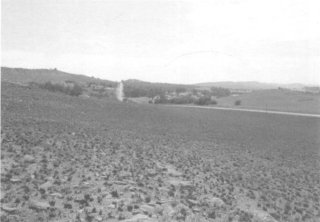
A view of the Dwarsvlei battlefield, looking northwards from
the side of Kopje 'G1', Kopje 'G2' appears on the right. The
guns were stranded in the hollow beyond, where the tar road
runs today. (Photo: J Shaw)
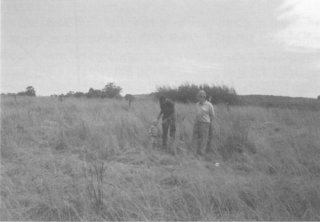
Hansie Viljoen with his son and grandson on the foundations
of the original farmhouse at Dwarsvlei. (Photo: J Shaw)
As the expected Scots Greys and two guns of the Royal Horse Artillery were pinned down and eventually captured by De la Rey at Zilikat's Nek, Lord Roberts signalled from Pretoria at 13.25 that the operation was to be cancelled and that the force must retire to Krugersdorp. Orders were issued for the withdrawal, but Lieutenant Turner, upon hearing of them from where he lay wounded next to the headquarters, burst out, 'Oh, you can't leave my guns!' Then, on Colonel Macbean's assurance that the Gordons could hold on all day, Smith-Dorrien cancelled the order.
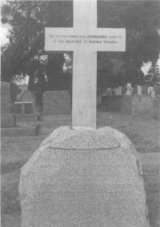
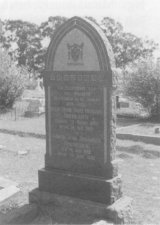
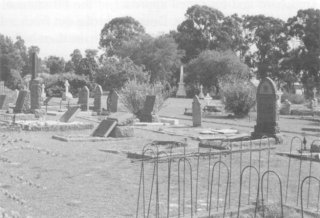
The proximity of the graves of Capt Younger (white cross, left)
and Vecht Generaal Sarel Oosthuizen (right) can be appreciated
in this view of Krugersdorp Cemetery (Photo: J Shaw)
A week later, the British resumed their mission, reinforced by Lord Methuen's force, and passed the same area on 19 July, observing a few Boers who kept their distance and put up but slight resistance later.(12)
In the Krugersdorp Cemetery, Captain Younger's headstone stands thirty paces away from the memorial stone to vecht-generaal Sarel Oosthuizen and his younger brother, korporaal Isak Johannes Oosthuizen (who died on 20 April 1902, a few days before the end of the war). The battle of Dwarsvlei has also been referred to as Leeuhoek, Doornboschfontein and Onrus, all being names of farms in the area that the action took place in that day.
Lord Hugh Montague Trenchard, 1873-1956
During August and September 1900, at Krugersdorp, Captain H M Trenchard of the 2nd Battalion of the Royal Scots Fusiliers had formed a mixed company of mounted infantry, made up mostly of Australian Bushmen.(13) At dawn on 9 October, after a night march to the west of the town, under General Barton, they had surprised a one hundred and fifty strong Boer encampment. Trenchard and his Australians pursued the fleeing Boers for 16 km into the hills around the farm Dwarsvlei, scene of the engagement three months earlier.
The valley was surrounded and all seemed quiet, so Trenchard and four men approached the farmhouse. As they neared the building, Boer fire broke out from a dozen points. Trenchard managed to reach the door before he was hit, pitching forward onto his face. Seeing their leader fall, the Australians poured down from the heights and a fierce battle raged until the Boers left. 'They had encouraged him [Trenchard] to walk into a trap of his own contriving.' In compliance with Lord Roberts's directive of the time, the house was then set alight.(14)
The bullet that hit Trenchard had pierced his left lung and damaged his spine, but he survived the wagon-journey back to Krugersdorp to find that he was half paralysed from the waist down and had lost the use of his legs. Miraculously, he fought his way back to health and just before his fortieth birthday, he took up flying to become one of the twenty pilots who were embodied as the Royal Flying Corps in 1912. He commanded the RFC in France, became the Chief of Air Staff of the Royal Air Force, and played a major role in the use of air power in the Second World War (1939-1945). He is buried in Westminster Abbey.
A new house was built on the farm Dwarsvlei after the war and today the foundations are all that remain of the original farmhouse. These were pointed out to the writer by Hansie Viljoen, grandson of Okker OosthLiizen, Sarel's brother, whose present house and farm buildings are only a short distance away.
Acknowledgements
The writer would like to thank J N Viljoen for information on his Oosthuizen ancestors and for showing him around the farm and enlightening him on Trenchard's connection with the area.
References
Amery, L S (ed), The Times History of the War in South Africa, (London, 1900-9).
Boyle, A, Trenchard, (Collins, St James's Palace, London, 1962).
Buchan, J, The Royal Scots Fusiliers. (Thomas Nelson, 1925).
Curruthers, V, The Magaliesberg, (Southern Books, Johannesburg, 1990).
Gardyne, A D C, History of the Gordon Highlanders, (Cooper, London, 1971).
Haywood, J B & Son, South African War - Honours and Awards, (Arms & Armour, London, l971).
Maurice, F, & Grant, M H, History of the War in South Africa, (Hurst & Blackett, London, 1908).
Naude, J E, Vechten en Vluchten van Beyers en Kemp, (Nijgh & Van Ditmar, Rotterdam, 1903).
Smith-Dorrien, H, Memories of forty-eight years' service, (J Murray, London, 1925).
Uys, I S, For Valour: The History of South Africa's VC Heroes, (Johannesburg, 1973)
Return to Journal Index OR Society's Home page
South African Military History Society / scribe@samilitaryhistory.org